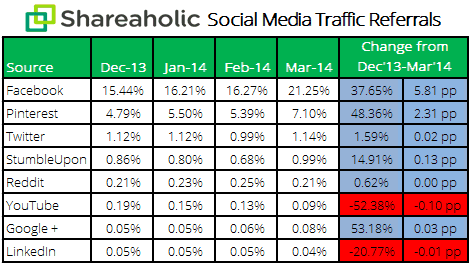 Media companies are having a hard time trying to get people to pay for digital news. When there are so many sites that just provide headlines and a few paragraphs of sensational context (which is what most people want, anyway), it’s difficult to convince readers that “news” is a product that’s worth any money.
Media companies are having a hard time trying to get people to pay for digital news. When there are so many sites that just provide headlines and a few paragraphs of sensational context (which is what most people want, anyway), it’s difficult to convince readers that “news” is a product that’s worth any money.
That’s why media companies have come to rely on advertising so heavily. Right now, 69% of all domestic news revenue is tied to advertising. And how do media companies ensure that they get the most potential exposure for advertisers? They bring in traffic. Lots and lots of traffic.
Facebook is responsible for a huge amount of that traffic, so it should be no surprise that the social media giant is enticing publishers with promises of lots of traffic and engagement in exchange for a deal in which, according to The New York Times, “media companies would essentially be serfs in a kingdom that Facebook owns.”
Serf’s Up
It’s no accident that journalistic strongholds like The Atlantic also seem to write a new-same article about social issues – or a dreaded piece about “millennials” – every week. Those are the kinds of articles that get the most shares and, incidentally, the most traffic. More people coming to the site means more advertising revenue. Sensation gets clicks so sensation gets written.
Facebook is a disproportionately big player in this space. This past spring, an analysis showed that Facebook drove 21.25% of the overall traffic sites received. The next highest is Pinterest (7.10%), followed by Twitter (1.14%).

You don’t have to look much further than Buzzfeed to see just how well socially optimized content can get people in through the door. Then, it’s just a matter of creating a relevant advertising experience and, hopefully, keeping them engaged on the site.
Facebook claims that a lot of media companies are providing a poor user experience when someone comes in from mobile. That’s important, considering that 78% of Facebook users in the US are using mobile to access the social network. So all the people being referred to a publisher’s content are transported from the seamless mobile experience of Facebook to the volatile, tiny-text quicksand of an external site.
Facebook’s solution is simple: media companies should host their content within the Facebook app.
As David Bradley, owner of The Atlantic Media Company explained to The Times:
“Increasingly, people would rather have their news curated by friends rather than editors,” he said. “Facebook technology may create a better reader experience than publishers can match — pages that load better and better page design.”
The trade-off is that if a newspaper’s content is hosted within a mobile app, then all of the social traffic isn’t actually going to the newspaper’s website. It’s going to Facebook. And, ultimately, Facebook gets to dictate the content. Anyone who has made a Facebook Page understands how quickly an algorithm can sweep away everything that you’ve built and make your Facebook Page invisible to fans.
When your content is owned by a third party platform, you are at the mercy of that platform’s publicly traded wishes. So yes, media companies would become serfs.
The Real Issue
Here’s the thing, though: social media traffic is impossible to ignore. Buzzfeed’s particular brand of sensationalist, insta-gratification posts attract more than 130 million unique visitors each month. Another company, PetFlow, has been curating YouTube videos and writing blog posts about them that get thrown out into the Facebook-O-Sphere. The result is a blog that gets 2 to 4 million views a day.
But guess what? The content is forgettable. It’s bite-size. It’s a digital shock to your systems. A quick zap of “ha ha” or “aww” or “how dare they!” and we’re back to work.
Worse, this kind of content doesn’t build reader loyalty. When every publication is competing for the same kind of content, the same brand of Cheeto-flavored news, there’s nothing to distinguish the actual journalists and media company responsible for the reporting.
Want proof? Over the past two years, The New York Times has lost half – 80 million in total – of the readers that go to the homepage.

This isn’t an indictment of New York Times content so much as a clear picture of social media adoption and distribution. Social media has become the defacto way to get the news out there. We click stuff our friends tweet or post, so we no longer visit the homepages of different publications. Sure, it happens – but social media is often our accidental-default source for news.
Consequently, the news has to be eye-popping. It’s not just competing with other hard-hitting investigative pieces, it’s competing with videos of cats and thin articles that confirm our own biases, tweeted by people with whom we already agree. It’s competing with our conception of what’s important, as dictated by what we see the people we’ve chosen to follow are now sharing and discussing.
The beauty and power of any media company is the ability to curate the news against what most readers are actively thinking. It’s the power to expose an issue that would have otherwise never gotten any light. But without the homepage, this is getting harder. And with the constant stream of identical content, it’s harder still for readers to feel the need to subscribe to one publication over another. Or pay for any news at all, when all they really need for social media is a headline.
In a socially optimized world, the headline is as good as the article.
Readers & Revenue in a Digital World
If media companies do decide to allow Facebook to host their content via a mobile app integration, they will be handing over the keys to their empire. They’ll be giving up the technological arms race, conceding defeat.
But why? The digital and mobile possibilities today are absolutely unprecedented. The first thing would be for media companies to develop a mobile app that blows away Facebook’s own mobile experience. If you can create a memorable, exciting mobile experience, you can start building loyalty again.
We’ve barely scratched the surface of what “digital” can do when it comes to storytelling. There are signs of hope, though. The BBC’s story about Vassilis Paleokostas wasn’t just great journalism: it was great digital journalism.
How far are media companies willing to push? A mobile app for media has to transcend the traditional concept of news. It has to incorporate rich media and flow seamlessly from story point to story point. A mobile-optimized media app should feel like an adventure.
With an app that completely redefines what “news” is supposed to look and feel like, media companies might be able to charge some money for it. Not only that, they’ll be able to collect user information and start targeting additional news stories and products a lot better.
Revenue is no longer going to be based on plain news stories that get people to come to the website. It’s going to based on providing a news experience, something that competitors aren’t as able to recreate. Multiple videos, galleries of photos, superb writing – all living together in digital storytelling harmony in an app or a mobile site.
Want to learn more? Visit For Writers.

Leave a comment